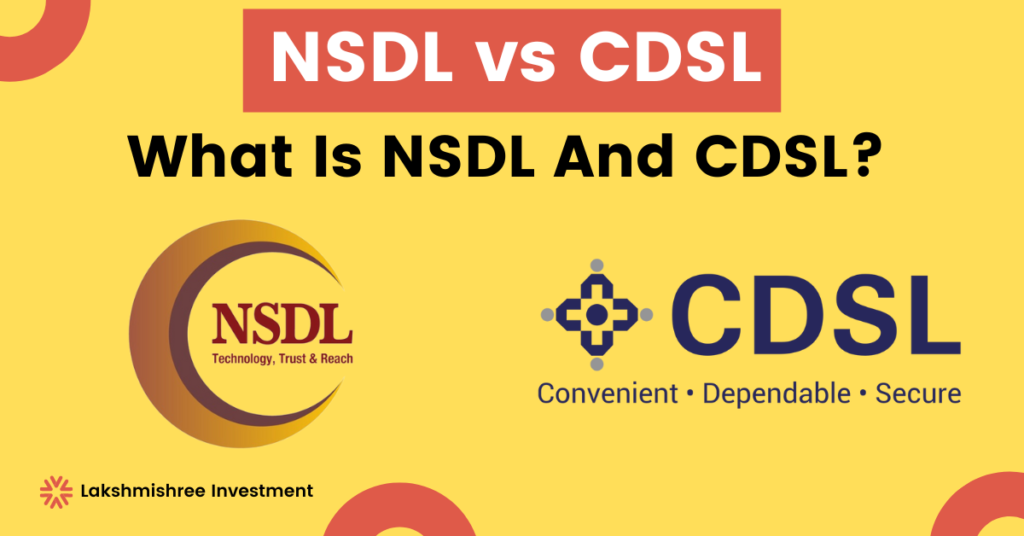
A depository is a place that acts like a bank for the financial securities which can be kept in dematerialized form. In India, the depositories act was passed in 1995, and with the introduction of the depository system providing certifications of shares ownership, forgery has become much less.
Currently, two central depositories are registered with SEBI; the NSDL and CDSL. Here we have discussed what is NSDL and CDSL, their benefits, and their differences.
National Securities Depository Limited was established in 1996 and handles securities in the Indian Capital Market. It was created to hold the shares, bonds, etc. in some physical or non-physical format. This technology system is very innovative and flexible and supports investors and brokers.
It is promoted by the Unit Trust of India (UTI), the National Stock Exchange (NSE), and the Industrial Development Bank of India (IDBI) with various other banks as shareholders. It provides services to investors, stock brokers, issuer companies, etc.
It aims to make the Indian Secondary market efficient, minimize risks and reduce costs.

Central Depository Securities Limited also known as CDSL is the first depository that was listed on the stock exchange. It received the certificate of commencement from the Securities Exchange Board of India (SEBI) in Feb 1999 and in 2017 it was listed through an IPO on NSE.
As on Feb 2022 they had 60 million active Demat accounts. And as on March 2022 more than 580 depository participants are associated with it.
It has a strong infrastructure system with multiple backup levels. They also offer an instant transfer of securities that are held in electronic form.
A Depositary Participant or also known as a DP is a licensed broker or an agent through which all the traders and investors place all the orders to buy or sell a security. They act as a middleman between the depository and the investors. The CDSL and NSDL cannot be contacted directly by the investor but through DP only.
Lakshmishree Investment is a Depositary Participant (DP) with the Central Depository Securities Limited (CDSL).
Securities Exchange Board of India (SEBI) approved the working of the depositories in India in 1995 and the first depository was set up in 1996, before that a physical share certificate was necessary to be owned and it was a very time taking process. The investors had to make sure that when they receive the certificate of owning a share it should be kept properly and should not get misplaced. The entire process of transferring the ownership of shares would take almost a month. Sometimes the transfer form was rejected if the sign in the company’s book did not match the sign on the transfer form or at other times there were chances that the certificates could get lost or damaged in moving from one city to another.
There are very minor differences between Central Depository Securities Limited and National Securities Depository Limited which are their names, account number format, and promoters. Their way of working is the same and they offer similar services to the investors. An investor uses these services through a depository participant (DP).
Some of the services provided by both of these depositories are:
A Demat account is necessary to make trades in the stock exchanges. When an investor purchases a stock through the broker, the depository (NSDL or CDSL) in which he has an account is instructed to transfer the shares to the Demat account. The same happens when he decides to sell a share after placing the order with his broker, the depository will transfer the share to the new owner of them.
After the depositories came into effect in India there have been changes in which the trades started to take place in the stock exchange. Some of the benefits of this were:
The services provided and the working format of both the depositories are very similar to each other but there are some differences between them also. Some of these are:
The Indian Stock Exchanges have come a long way since the Independence. Earlier what used to take days now can be done with just a click of a button. To make the transfer of the ownership of shares of a company used to be a long and often burdening process. But when SEBI gave the clearance to establish the depositories in 1995 the pace at which transactions were placed changed. Technology played a major role in the successful running of these depositories. The NSDL and CDSL were formed and backed by NSE and BSE respectively.
Both of these depositories provide similar services and have made trading easier for traders and investors. But they are also slightly different in some areas but only in small ways. CDSL is the larger depository based on active accounts.
If the account number starts with ‘IN’ and then is followed by 14 numeric digits it is opened with NSDL while if it only has 16 numeric digits it is with CDSL.
The full form of BO ID is the Beneficial Owner Identification Number. It is a 16-digit account number of a client with 8 digits of DP Id and 8 digits of client Id.
Yes, shares can be transferred from CDSL to NSDL and vice-versa by using CDSL’s Easiest facility or NSDL’s Speed-e facility. It can also be done manually by submitting a physical Delivery Instruction Slip (DIS).
Both the depositories are very similar and it is impossible to choose between them. An investor does not get a choice as the Depositary Participant is the one to choose between the two depositories.
